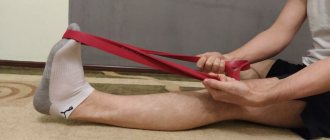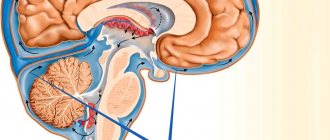Cramps are involuntary muscle contractions that cause spasms. Such manifestations occur suddenly, do not last long, and may recur periodically. They often cause severe pain, especially in the elderly and children. Most often, cramps appear in the lower extremities, thigh muscles, and calves. The neck, back, hands, and abdomen are susceptible to these painful manifestations. Spasms of internal organs are quite rare. With regular repetitions, convulsive syndrome is diagnosed.
Types of seizures
All categories of people can experience seizures, regardless of age and lifestyle; they appear more often in the elderly and young children. Attacks are manifested by unequal painful muscle contractions and have different durations, mechanisms of development and frequency of occurrence. They are classified according to several criteria.
By locality
Depending on whether one muscle or a group of them is seized by a spasm, spasms are divided into:
- unilateral – when pain occurs on one side;
- focal (local) - appear in one muscle group;
- generalized - affect the whole body, causing involuntary urination, loss of consciousness and even respiratory arrest.
By duration of exposure
Classified into:
- myoclonic - short-term contractions or twitches, mainly in the upper part of the body, stop quickly and do not cause pain;
- clonic - characterized by a longer duration, muscles contract rhythmically, can be of a local or general type, sometimes contribute to stuttering;
- tonic – long-term, can occur in any part of the body, affect the respiratory tract, the part of the body seized by a convulsion takes one forced position, can lead to loss of consciousness;
- tonic-clonic - in which tonic spasms turn into clonic; if the second type predominates, they are called clono-tonic.
When to see a doctor
Muscle spasms and twitching are not a cause for concern and go away on their own. They are completely normal, especially among athletes and people involved in physical labor.
However, in some cases, cramping may indicate a medical condition such as multiple sclerosis, thyroid disease, or cirrhosis of the liver. These diseases are related to nutrition, blood supply, metabolism, nervous or hormonal system.
If severe or painful muscle spasms become a regular occurrence, you should make an appointment with your doctor.
Causes of seizures
There are several factors that influence the occurrence of seizures.
Occupational activities - People whose jobs involve standing in a single position all the time (salespeople, computer operators, etc.) or who are exposed to repetitive physical stress experience cramps at night or in the evening. People who smoke experience muscle cramps 5 times more often; the leading causes of cramps are smoking or extremely frequent drinking of coffee.
Often night cramps appear after a day spent in constant movement or even an ordinary brisk walk - this becomes the cause of calf cramps. The same result causes unusual significant physical stress. It should be taken into account in advance that it is undesirable to strain one muscle group; physical work should alternate with periodic rest.
Night cramps are much more common because the posture of the sleeping person contributes to this: relaxed and downward-facing feet, bent legs and the body turned on its side. This position shortens the calf muscle and helps cause spasms. Night leg cramps occur in athletes after significant daytime stress, children (especially with fever) and the elderly due to circulatory disorders in the extremities.
Severe cramps are not uncommon when swimming in cool water on a hot day. Temperature changes can also cause spasms in the pool: heated muscles contract sharply with sudden changes in the environment.
Cramps also appear as a result of severe dehydration, especially in those who engage in sports training or heavy physical labor in the hot season.
Stressful conditions can cause convulsions, and the effect does not occur immediately, but after a while, when calcium is redistributed in the body due to an excess of the hormone cortisol.
Spasms of the fibers of the foot muscles can appear as a result of wearing tight shoes or high loads with flat feet.
Another reason that leads to cramps in the arms and legs is the uncontrolled use of statins, dauretics, antibiotics and other drugs that redistribute or remove microelements from the body. Drug treatment of seizures is carried out with mandatory monitoring of the biochemical composition of the blood.
Why do cramps happen?
Where muscle spasms come from is not entirely clear to science. Often the cause cannot be established (however, if the cramp is a one-time occurrence, we don’t really try).
But there are situations that often precede a spasm. Here are the seven most common causes of What Causes Muscle Cramp? seizures
Muscle strain
Often, cramps are the result of an overly energetic approach to equipment in the gym. The resulting sprains and other microtraumas during the healing process can be accompanied by Sprains and Strains not only pain (soreness), but also muscle cramps.
Circulatory disorders
A classic example is carpal tunnel syndrome. This is the bane of those who spend too much time with a computer mouse in their hand. Due to the constant fixed and unnatural position of the wrist, blood circulation in the muscles is impaired. The consequence of this can be pain and muscle weakness, as well as cramps.
A couple more common special cases:
- Uncomfortable shoes . Shoes with unusually high heels, uncomfortable lasts, flip-flops that you have to keep on your feet by tucking your toes. The muscles get so used to the unnatural tension that then, when you are finally freed from the “Spanish boot”, they cannot relax, they go into spasm.
- Uncomfortable position while sleeping . Stiff arms, legs, neck - all this is also a sign of poor circulation and can provoke Causes and treatment for leg cramps cramps at night.
Overheating and/or dehydration
It doesn’t matter what exactly caused the overheating: summer heat, intense physical activity, or, say, high temperature due to infections. The main thing is that along with the sweat released, the body loses not only moisture, but also electrolytes necessary for the correct transmission of nerve impulses. The muscles react to this, including cramps.
Mineral depletion
Not having enough potassium, calcium, or magnesium can make it difficult for your muscles to relax. And this leads to seizures.
Nervous strain or neurological disorders
In such conditions, it is often difficult for the muscles to relax. You already know the consequences.
Pregnancy
Leg cramps are familiar to many expectant mothers. The reasons for this are still not entirely clear to doctors. What causes leg cramps during pregnancy, and can they be prevented? .
Certain diseases and certain medications
Muscle spasms often accompany ailments such as diabetes, kidney problems, and thyroid disorders. They can also be a side effect of taking certain medications. Why Is My Leg Cramping? What Can Help? . For example, furosemide and other diuretics, as well as drugs for the treatment of angina, osteoporosis, Alzheimer's disease and others.
Diseases and consequences
In addition to circumstances related to lifestyle or specific events, the muscular system may be subject to cramps due to the presence of a specific disease, to identify which it is necessary to seek help from medical institutions for examinations, tests and treatment.
Spasms can be symptoms of unrelated diseases. We can say that leg and arm cramps differ from spasms that occur in smooth muscle fibers and cause pain inside the body, which most often indicate diseases that require regular treatment.
If we characterize the main diseases leading to seizures, their list will look like this:
- epilepsy and concomitant epileptic seizures cannot do without muscle cramps;
- opisthotonus, better known as tetanus, is necessarily accompanied by severe spasms;
- there is such a thing as psychogenic convulsions, characteristic of hysterical neuroses and other neurotic conditions;
- inorganic and organic poisons also cause involuntary contractions of muscle tissue;
- The most common factor leading to severe muscle tension is an excess or deficiency of microelements such as magnesium, potassium and others.
Improper distribution of microelements is caused by various reasons. Failure of the endocrine system requires serious treatment prescribed by a doctor, and metabolic disorders caused by other reasons can be corrected with medications.
Why do muscles cramp?
Most often, muscles cramp due to dehydration or physical fatigue.
Insufficient water intake, especially in hot climates, leads to muscle cramps. Athletes are at risk because physical activity causes excessive sweating. If you train or compete in the heat, be sure to monitor your intake of water or sports drinks, which replenish electrolytes (sodium, potassium) lost through sweat.
Exercise-related muscle cramps are a common condition experienced by amateur and professional athletes. Since water is involved in muscle contraction and relaxation, insufficient fluid intake during intense and prolonged exercise can lead to subsequent cramping.
People often experience cramps at night: according to statistics, leg cramps occur at night in 75% of cases, and every third adult has experienced cramps in the calf muscles in the dark. This is due to the fact that tendons naturally shorten with age, so the older you get, the higher the likelihood of night cramps: the load accumulated during the day will make itself felt at the most inopportune moment.
Sometimes cramps can be caused by medical conditions. The following are the most common causes of seizures:
- Cirrhosis of the liver
- Hypothyroidism
- Malnutrition (deficiency of vitamins B, D and magnesium)
- Uremia
- Amyotrophic lateral sclerosis
- Charcot-Marie-Tooth disease
- Benign crampy-fasciculation syndrome
- Radiculopathy
- Neuromyotonia
- Metabolic myopathies
- Parkinson's disease
- Dystonia
- Multiple sclerosis
- Stroke
Nerve spasm can also be caused by taking beta-agonists, diuretics, and statins.
What to do if you have seizures
Muscle contractions that are not associated with serious illness do not require specialized treatment, but the pain they cause does need to be addressed. Therefore, there are simple methods that have proven their effectiveness:
- massaging or shocking frozen muscles;
- elimination of spasm with an injection of a regular needle;
- massage stiff calf muscles - pull your big toes towards you;
- the same group of muscles relaxes with the help of standing stretches - with your hands, reach the fingers of the sore limb resting on the floor surface;
- when the muscles of the front surface of the thighs spasm, the knee bends, and the foot is pulled from behind towards the buttocks.
These methods allow you to get rid of the pain that has arisen, but if it appears quite often, the treatment of seizures should begin with identifying the causes that cause them and prevention.
Magnesium and potassium
Cramps that periodically appear in the feet, legs, and fingers can occur in people who consider themselves to be completely healthy. Treatment of this unpleasant and painful sensation must begin with a review of the lifestyle and nutritional composition.
It is necessary to understand whether there is enough magnesium and potassium in the diet, the lack of which can not only lead to seizures, but also make them permanent. It is these microelements that regulate the functioning of muscle fibers. Hypomagnesemia causes cramps in the legs, arms, back, neck, and tingling of the fingertips. Treatment with drugs for seizures can relieve pain.
How to prevent seizures
Measures aimed at eliminating and preventing the occurrence of seizures should include:
- giving up harmful addictions (smoking, excessive consumption of alcohol, coffee, tonic drinks); — sufficient daily fluid intake; — physical education to improve blood circulation; - enriching the body with vitamins and microelements (deficiencies in specific compounds can be identified using tests); - Night cramps can be prevented by a warm bath or shower.
To treat and prevent seizures, purchase a complex containing magnesium as a therapeutic measure. Even if there is no deficiency of this mineral in the body, it acts as an anticonvulsant element that reduces neuromuscular excitability.
Magvit is an excellent cure for seizures
One of the most affordable, safe and effective medicines for treating seizures is the drug “Magvit” , produced by the Belarusian pharmaceutical company “Minskintercaps”.
This is the first drug completely developed by domestic pharmacists and has a beneficial effect in the treatment of seizures.
“Magvit” successfully fights both primary and secondary magnesium deficiency, and the pyridoxine (vitamin B6) included in the drug improves the absorption of magnesium into the blood and its absorption at the cellular level.
The combined use of vitamin and magnesium citrate components of the drug is justified by the following clinically proven data:
- magnesium and B6 enhance and complement the pharmacological effects; — the vitamin helps reduce the amount of magnesium excreted from the body and increases its content in red blood cells; - absorption and assimilation of magnesium improves; - Pridoxine, under the influence of magnesium in the human liver, transforms into the active metabolite pyridoxal-5-phosphate.
Primary causes of seizures
Reduces muscles throughout the body (the causes directly affect the direction of treatment) in people for two types of reasons: primary and secondary.
The primary circumstances that provoke the occurrence of seizures are usually attributed to:
- disorders of the body's metabolic processes;
- intoxication;
- feverish conditions;
- hypoxia;
- pre-stroke condition;
- epilepsy;
- inflammatory processes of the brain;
- congenital pathologies of the brain and nervous system;
- disorders of the thyroid gland;
- hormonal imbalances (except in cases of side effects while taking oral contraceptives).
Advantages of Minskintercaps drugs
The company has earned well-deserved fame thanks to the production of inexpensive, high-quality medicines. All drugs comply with the requirements of the GMP standard, and their quality and composition are tested in a chemical and biological laboratory accredited in accordance with the requirements of STB ISO/IEC 17025.
The drugs are created from raw materials supplied by the world's leading companies; production is controlled by Pharmacovigilance and meets the requirements set by the European Parliament.
13 Feb 2018
Previous News Feed Next










